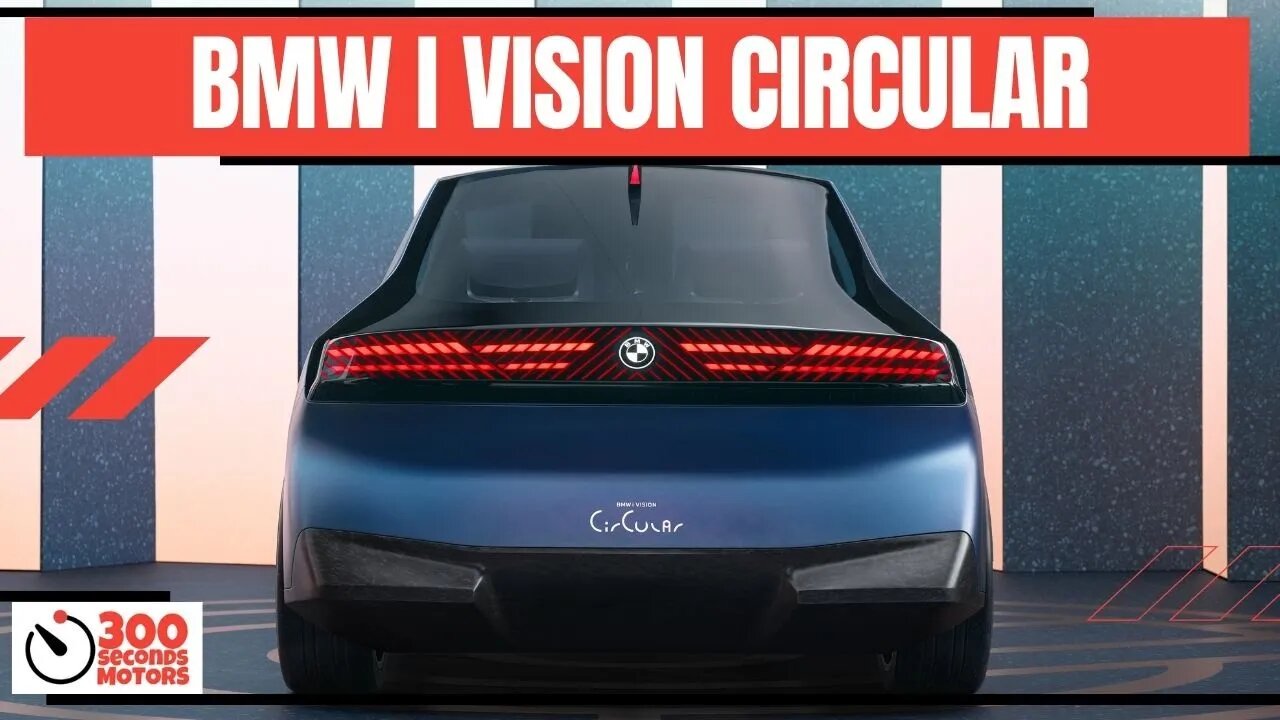Premium Only Content

BMW I VISION CIRCULAR is looking ahead to a compact car for the year 2040
With the BMW i Vision Circular, the BMW Group is looking ahead to a compact BMW for the year 2040 that is focused squarely on sustainability and luxury. The four-seater is fully electrically powered and offers a generous amount of interior space within its around four-metre-long footprint. It has furthermore been designed according to circular economy principles across the board and therefore symbolises the BMW Group’s ambitious plan to become the world’s most sustainable manufacturer in the individual premium mobility space.
The Vision Vehicle is one of five different concept vehicles with which the BMW Group is presenting how it envisages individual urban mobility at the IAA Mobility 2021 event. Under a single umbrella spanning electric mobility, digitalisation and sustainability, the five pioneering concepts create a versatile mobility mix on two and four wheels fuelled by sustainable thinking, which comprehensively addresses an extremely wide range of mobility needs in the face of fast-changing requirements and growing challenges.
Circular economy and secondary materials cut CO2 emissions.
The BMW Group’s overriding aim as it strives to achieve climate neutrality is to reduce CO2 emissions throughout a vehicle’s entire life cycle. Besides electrifying the product portfolio and switching to renewable energy for manufacturing, the company is focusing particularly on circular economy principles and the use of secondary materials. These materials, such as secondary aluminium and secondary steel, can be obtained by recycling waste material and then reused. The process for supplying secondary materials is far less harmful to the environment and carbon intensive compared to the extraction and manufacture of primary material. This can bring about a major improvement in a vehicle’s carbon footprint, especially on the supply chain side. At present, vehicles from the BMW Group are manufactured using nearly 30 per cent recycled and reused material on average. The ‘secondary first’ approach is intended to gradually increase this figure to 50 per cent.
The overriding design aim for the BMW i Vision Circular was to create a vehicle that is optimised for closed materials cycles and achieves 100% use of recycled materials / 100% recyclability. This involves making particular use of materials that have already completed a product life cycle – or secondary materials as they are known – alongside certified bio-based raw materials. The same applies to the energy storage device: the all-solid-state battery in the BMW i Vision Circular is 100 per cent recyclable and manufactured almost entirely using materials sourced from the recycling loop. It will achieve much higher energy density with significantly reduced use of the most valuable resources.
Circular design – a new approach.
“We gave thorough consideration to circularity from the outset during the design process for the BMW i Vision Circular. As a result, this Vision Vehicle is packed with innovative ideas for combining sustainability with a new, inspirational aesthetic – we call this approach ‘circular design’,” explains Adrian van Hooydonk, Head of BMW Group Design. Circular design embraces the four principles of RE:THINK, RE:DUCE, RE:USE and RE:CYCLE.
RE:THINK. Circular product design begins by thinking about things differently. For the BMW i Vision Circular this meant scrutinising processes and manufacturing technologies and thinking differently. The function performed by each component part up to now was examined, after which the part was removed without replacement or cleverly repackaged where appropriate and then designed to enable closed materials cycles.
RE:DUCE. “I do more with less” has long been an integral part of the BMW i philosophy. The BMW i Vision Circular demonstrates this through the rigorously applied reduction in the number of component parts, material groups and surface finishes, dispensing completely with exterior paintwork, leather and chrome, for instance. Materials from bio-based raw materials also help to minimise environmental impact and contribute to a smaller carbon footprint. As far as the digitalisation features are concerned, smart control panels reduce both complexity and the use of materials. In addition to this, digital surface treatments enable a reduction in the number of hardware variants at the same time as opening up whole new possibilities for design.
Track: Time To Talk & Avaya Ft.RYVM - Found You [NCS Release]
Music provided by NoCopyrightSounds
Free Download/Stream: http://ncs.io/FoundYou
#bmw #iVISION #bmwiVISION
-
 5:00
5:00
300 Seconds Motors
3 years agoNISSAN debuts trio of 2022 FRONTIER concepts at Chicago Auto Show
333 -
 LIVE
LIVE
Akademiks
40 minutes agoSheck Wes exposes Fake Industry. Future Not supportin his mans? D4VD had help w disposing his ex?
1,006 watching -
 LIVE
LIVE
SpartakusLIVE
4 hours agoTeam BUNGULATORS || From HUGE WZ DUBS to TOXIC ARC BETRAYALS
1,888 watching -
 LIVE
LIVE
BlackDiamondGunsandGear
35 minutes agoAre You that guy? / After Hours Armory
32 watching -
 LIVE
LIVE
Camhigby
55 minutes agoLIVE - Riot Watch Portland, DC, NC
200 watching -
 LIVE
LIVE
CAMELOT331
3 hours agoYouTube Just Told Me I OWE THOUSANDS $ TO THEM... update
204 watching -
 LIVE
LIVE
Tundra Tactical
10 hours ago🛑LIVE AT 9PM CST!! Your Government Hates Your Guns : DOJ Holds Firm On National FIREARMS ACT
121 watching -
 LIVE
LIVE
DLDAfterDark
1 hour agoAre YOU The Guy That Ruins Thanksgiving?? - God Guns & Gear
64 watching -
 LIVE
LIVE
NewsTreason
2 hours agoDECLAS w/ Rambo & Dave: Nuremberg 2.0 | MTG Exits Stage Left | Mamdani Psyop Confirmed, 8pm EST
7,646 watching -
 LIVE
LIVE
meleegames
2 hours agoSONG REQUESTS CLOSED - Melee Music - Beat Hazard 3 - Devil Inside
126 watching